Winter of discontent
Page 35
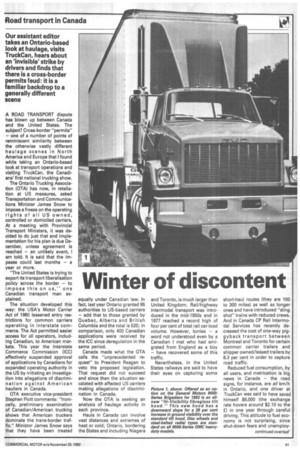
Page 36
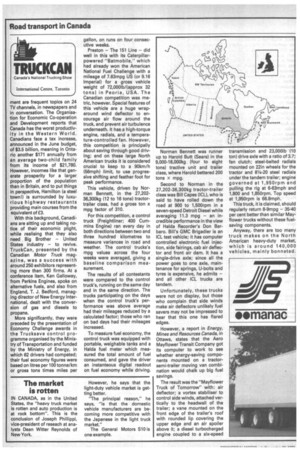
Page 37

Page 38
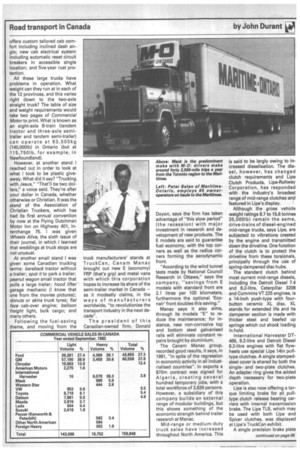
Page 40
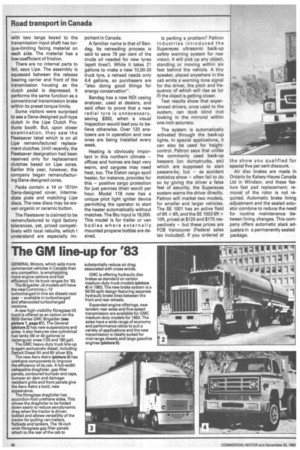
Page 41
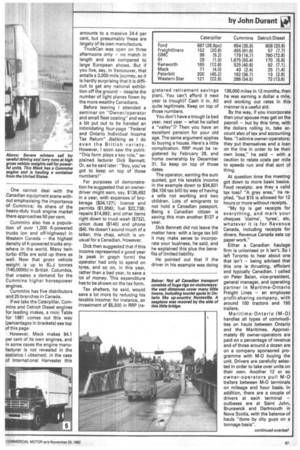
Page 42
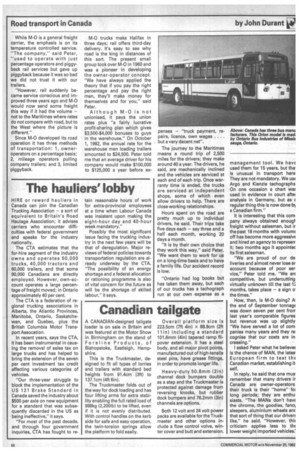
If you've noticed an error in this article please click here to report it so we can fix it.
A ROAD TRANSPORT dispute has blown up between Canada and the United States. The subject? Cross-border "permits" — one of a number of points of reminiscent similarity between the otherwise vastly different haulage scenes in North America and Europe that I found while taking an Ontario-based look at transport operations and visiting TruckCan, the Canadians' first national trucking show.
The Ontario Trucking Association (OTA) has now, in retaliation at US measures, asked Transportation and Communications Minister James Snow to impose a freeze on the operating rights of all US owned, controlled or domiciled carriers. At a meeting with Provincial Transport Ministers, it was decided to do just that and implementation for his plan is due December, unless agreement is reached — an unlikely event, I am told. It is said that the impasse could last months — a year or more.
"The United States is trying to export its transport liberalisation policy across the border — to impose this on us," one Canadian transport man explained.
The situation developed this way: the USA's Motor Carrier Act of 1980 lessened entry restrictions for common carriers operating in interstate commerce. The Act permitted easier access for all operators, including Canadian, to American markets. This year the Interstate Commerce Commission (ICC) effectively suspended approval of applications by Canadians for expanded operating authority in the US by initiating an investigation into allegations of discrimination against American hauliers in Canada.
OTA executive vice-president Stephen Flott comments: "Ironically, preliminary examination of Canadian/American trucking shows that American truckers dominate the trans-border traffic." Minister James Snow says that they have been treated equally under Canadian law. In fact, last year Ontario granted 95 authorities to US-based carriers — add that to those granted by Quebec, Alberta and British Columbia and the total is 520; in comparison, only 400 Canadian applications were received by the ICC since deregulation in the same period.
Canada made what the OTA calls the "unprecedented request" to President Reagan to veto the proposed legislation. That request did not succeed and since then the situation escalated with affected US carriers making allegations of discrimination in Canada.
Now the OTA is seeking an analysis of haulage activity in each province.
Hauls in Canada can involve vast distances and extremes of heat or cold; Ontario, bordering the States and including Niagara and Toronto, is much larger than United Kingdom. Rail/highway intermodal transport was introduced in the mid-1950s and in 1977 reached a record high of four per cent of total rail car-load volume. However, lorries — a word not understood even by a Canadian I met who had emigrated from England as a boy — have recovered some of this traffic.
Nevertheless, in the United States railways are said to have their eyes on capturing some
short-haul routes (they are 100 to 300 miles) as well as longer ones and have introduced "sling shot" trains with reduced crews. And in Canada CP Rail Intermodal Services has recently decreased the cost of one-way piggyback transport between Montreal and Toronto for certain common carrier trailers and shipper owned/leased trailers by 8.3 per cent in order to capture road traffic.
Reduced fuel consumption, by all users, and metrication is big news in Canada — the road signs, for instance, are all km/h in Ontario, and one driver at TruckCan was said to have saved himself $6,000 (the exchange rate hovers around $2.10 to the C) in one year through careful driving. This attitude to fuel economy is not 'surprising, since shut-down fears and unemploy ment are frequent topics on 24 TV channels, in newspapers and in conversation. The Organisation for Economic Co-operation and Development reports that Canada has the worst productivity in the Western World. Canadians face a tax increase, announced in the June budget, of $3.5 billion, meaning in Ontario another $171 annually from an average two-child family from its income of $21,780. However, incomes like that generate prosperity for a larger proportion of the population than in Britain, and to put things in perspective, Hamilton (a steel town!) is surrounded by luxurious highway restaurants providing main courses from the equivalent of M.
With this background, Canadians are sitting up and taking notice of their economic plight, while realising that they also need Big Brother — United States industry — to revive. TruckCan, presented by the Canadian Motor Truck magazine, was a success with around 250 exhibitors representing more than 300 firms. At a conference item, Ken Galloway, from Perkins Engines, spoke on alternative fuels, and also from England, T. J. Bedford, managing director of New Energy International, dealt with the conversion of gas and diesels to propane.
More significantly, they were preceded by the presentation of Economy Challenge awards in the Trucksave control programme organised by the Ministry of Transportation and funded by the Ministry of Energy, in which 62 drivers had competed; their fuel economy figures were based on litres per 100 tonne/km or gross tons times miles per gallon, on runs on four consecutive weeks.
Preston — The 151 Line — did well in this with its Caterpillarpowered "Batmobile," which had already won the American National Fuel Challenge with a mileage of 7.63mpg US (or 9.16 Imperial) for a gross vehicle weight of 72,000Ib/(approx 32 tons) in Peoria, USA. The Canadian competition was metric, however. Special features of this vehicle are a huge wraparound wind deflector to encourage air flow around the truck, and prevent air turbulence underneath. It has a high-torque engine, radials, and a temperature-controlled fan. However, this competition is principally about saving through good driving; and on these large North American trucks it is considered crucial to keep to a 90km/h (56mph) limit, to use progressive shifting and feather foot for peak performance.
This vehicle, driven by Norman Bennett, in the 27,20236,300kg (12 to 16 tons) tractortrailer class, had a gross ton x mpg factor of 310.
For this competition, a control truck (Freightliner; 400 Cummins Engine) ran every day in both directions between two and three hundred kilometres to measure variances in road and weather. The control trucks's mpg values across the four weeks were averaged, giving a baseline comparison measurement.
The results of all contestants were compared to the control truck's, running on the same day and in the same direction. The trucks participating on the days when the control truck's performance was above average had their mileages reduced by a calculated factor; those who ran on bad days had their mileages increased.
To measure fuel economy, the control truck was equipped with portable, weighable tanks and a Heide fuel meter which measured the total amount of fuel consumed, and gave the driver an instanteous digital readout on fuel economy while driving.
Norman Bennett was runner up to Harold Butt (Sears) in the 9,000-18,000kg (four to eight tons) tractive unit and trailer class, where Harold bettered 200 tons X mpg,
Second to Norman in the 27,202-36,300kg tractor-trailer class was Bill Capes (ICL), who is said to have rolled down the road at 900 to 1,500rpm in a seven-speed Detroit Diesel while averaging 11.3 mpg — an incredible performance in the view of Heide Recorder's Don Barbaro. Bill's GMC Brigadier is an ICL test vehicle; it has computer controlled electronic fuel injection, side fairings, cab air deflector and front air dam. It has a single-drive axle; since all the power goes to one axle, maintenance for springs, U-bolts and tyres is expensive, he admits — and all other ICL trucks are tandem.
Unfortunately, these trucks were not on display, but those who complain that side winds make air deflectors unlikely fuel savers may not be impressed to hear that this one has flared edges.
However, a report in Energy, Mines and Resources Canada, in Ottawa, states that the Aero Mayflower Transit Company got its computer to work to see whether energy-saving components mounted on a tractorsemi-trailer moving van combination would chalk up big fuel savings.
The result was the "Mayflower Truck of Tomorrow" with: air deflector; a vortex stabiliser to control side winds, attached vertically to the headwall of the trailer; a vane mounted on the front edge of the trailer's roof with rounded lip covering the upper edge and an air spoiler above it; a diesel turbocharged engine coupled to a six-speed transmission and 23,000lb (10 ton) drive axle with a ratio of 3.7; fan clutch; steel-belted radials mounted on 22in wheels for the tractor and 81/4-20 steel radials under the tandem trailer; engine governed at 1,950rpm and pulling the rig at 6-63mph and 1,800 and 1,850rpm. Top speed at 1,950rpm is 66.8mph.
This truck, it is claimed, should regularly return 8-9mpg — 35-40 per cent better than similar Mayflower trucks without these fuelsaving components.
Anyway, there are too many truck makes on the North American heavy-duty market, which is around 140,000 vehicles, mainly bonneted.
Mack, which has a small assembly operation in France, where. the EEC import duty is 22 per cent compared with four per cent in the USA — "not really free trade" — is pushing in the cab-over market and at TruckCan introduced a new model. Alfred Pelletier, chairman, interviewed in Motor Truck, asked about rumours of sale by his parent company, said there had been no recent offer. Competition in the truck market worldwide is tough, he said; 23 or 25 manufacturers had bid for an Australian Army heavy-duty order, and Leyland, Hino and Mack were short-. sted.
Prototypes were more severely tested than ever before; after six months BL caved in. Hino was priced thousands of dollars below Mack, but on a life-cycle analysis Mack won the order.
However, MAN used the show to join notably, Mack, GMC, IH, Ford, Freightliner, Peterbilt and Canada's Western Star, on the market. When ' Motor Truck's Hugh Quigley road tested a Mercedes-Benz 1316 he wrote: "We may never see European tractors on Canadian highways ... "
After testing an MAN DFLT (gcw 45,000kg or 44 tons) he changed his mind. He was surprised to find that its cab is much smaller than a Kenworth's, yet much roomier. On the other hand the drivers, who were at the show in numbers on Sunday, were not crowding the MAN stand in the way they surrounded the big, chromy American rigs.
The MAN has an in-line six cylinder engine with direct-injection exhaust turbocharging with intercooling and wet cylinder liners, and develops 260kW {350bhp) SAE at 1,900rpm; its gearbox is a Fuller RIO 9513 with 13 forward and two reverse gears with overdrive splitter.
Driving it, Hugh found a joy; he says it has many features new to Canada but proved in Africa, and he is fairly sure it will sell well.
So who splits? Perhaps the last to produce the 500,000-mile truck — with back-up; a more conceivable objective than the world truck.
In Canada, Japanese cars and cameras apart, they have seen them come and seen them go — like British cars (I saw just four or five Minis; no Metros). One truck the Hayes, designed for loggers, though a low-volume production, exported to Spain. It disappeared in 1975.
• The Sicard, built in Montreal, lasted until 1971. Two more recent specialist marques reached a volume of about 50 trucks before ceasing production. Various overseas firms have given up trying to cope with Arctic winters and almost tropical summers, where air conditioners, auxiliary heaters and winter fronts are needed on the same vehicle, and even local car drivers may carry an axe and waterproof matches just in case they get stuck and need a fire in order to keep alive.
The existing North American marques have been joined for some time by Wino, a firm that should not be just dismissed as the one that was accused of trying to get into Britain via the back door — Ireland. It tops the diesel exports league in Japan and at TruckCan produced an atlas page showing its staggering number of outlets in 1981 when the total units reached 29,743. However, in figures it produced for 1980, Mercedes-Benz led the field in exports, the figures being: Merc 71,126; Hino 25,971; followed by Volvo, lsuzu, Scania, Nissan Diesel, Ford UK, Bedford, Fiat and Unic. Last year Hino sold just 434 units in North America (3,6 4 4 in South America).
Like MAN, it did not draw the crowds in Toronto, which went to the chromy American trucks. North American makers are bringing out more improvements to appeal to enthusiastic drivers. International has new walk-in double sleepers in its Eagles, for example; its 4200/4300 range has-an easy to repair cab
with large, flat, riveted sections and flat doors — a two-piece windshield makes for less expensive replacement. This range has new fuel saving engines, IH air deflector and new suspension options.
The Eagle cab-over — "at last a heavy truck that doesn't ride like one, feel like one or treat you like one" — is claimed to have more leg room, 38.5in from clutch to seetback, than any comparable truck; "the most belly room too," an adjustable steering column as standard, and 12 powered ventilation ducts, etc. Ford's "long-nose" LTL-9000 — special wheelbases of 7.1m (280in) or longer — offers a wide choice of high and low-back seats. Cummins, Caterpillar or Detroit Diesel constitute nine engine options.
Canada's Western Star, a typical bonneted job with a rugged look, nevertheless now offers custom tailored cab comfort including inclined dash angle; new cab electrical system including automatic reset circuit breakers in accessible single location; and five-year rust protection.
All these large trucks have problems in operation. What weight can they run at in each of the 12 provinces, and this varies right down to the two-axle straight truck? The table of size and weight requirements would take two pages of Commercial Motor to print. What is known as an eight-axle B-train (tandem tractor and three-axle semitrailer and tandem semi-trailer) can operate at 63,500kg (140,0001b) in Ontario (but at 115,750Ib, for example, in Newfoundland).
However, at another stand I reached out in order to look at what I took to be plastic giveaway. What did it say? "Trucking with Jesus." "That'll be two dollars," a voice said. They're after your dollar in Canada, whether otherwise or Christian. It was the stand of the Association of Christian Truckers, which has had its first annual convention by now at the Flying Dutchman Motor Inn on Highway 401, Interchange 75. I was given Wheels Alive, the sixth issue of their journal, in which I learned that weddings at truck stops are not unusual.
At another small stand I was given some Canadian trucking terms: bareback tractor without a trailer; spot it to park a trailer; peanut wagon small tractor that pulls a large trailer; hood lifter garage mechanic (I know that one from the movies pictures); donuts or skins truck tyres; flat face cab-over engine; balloon freight light, bulk cargo; and many others.
Following the fuel-saving theme, and moving from the truck manufacturers' stands at TruckCan, Canam Manac brought out new E (economy) FRP (that's grp) and metal vans with which this corporation hopes to increase its share of the semi-trailer market in Canada as it modestly claims, in the ways of manufacturers worldwide, "to revolutionise the transport industry in the next decade".
The president of this Canadian-owned firm, Donald Doyon, says the firm has taken advantage of "this slow period" (the recession) with major investment in research and development of new products. The E models are said to guarantee fuel economy, with the top corners as well as the radius corners forming the aerodynamic front.
"According to the wind tunnel tests made by National Council Research in Ottawa," says the company, "savings from E models with standard front are 2.1 litres per 100 kilometers, furthermore the optional 'Econair' front doubles this saving."
Manac says it also aims, through its models "E" to reduce the maintenance; for instance, new non-corrosive top and bottom steel galvanised rails will eliminate constant repairs brought by aluminium.
The Canam Manac group, recorded good results, it says, in 1981, "in spite of the regression in economic activity in all industrialised countries". In exports a $70m contract was signed for Algeria, creating several hundred temporary jobs, with a total workforce of 3,839 persons. However, a subsidiary of this company builds an external range of modular buildings, but this shows something of the economic strength behind trailer research at Manac.
Mid-range or medium-duty truck sales have increased throughout North America. This is said to be largly owing to increased dieselisation. The diesel, however, has changed clutch requirements and Lipe Clutch Products, Lipe-Rollway Corporation, has responded with the industry's broadest range of mid-range clutches and featured in Lipe's display. Although the gross vehicle weight ratings 8.7 to 15.6 tonnes 35,0001b) remain the same, drive-trains of diesel-engined mid-range trucks, says Lipe, are subjected to vibrations created by the engine and transmitted down the drive line. One function of the clutch is to protect the driveline from these torsionals, principally through the use of spring-dampened disc hubs.
The standard clutch behind most current mid-range diesels, including the Detroit Diesel 7.4 and 8.2-litre, Caterpillar 3208 and Cummins VT 225 engines, is a 14-inch push-type with fourbutton ceramic XL disc. XL stands for extended life and its dampener section is made with thicker steel and beefed up springs which cut shock loading in hold.
International Harvester DT
466, 9.2-litre and Detroit Diesel 8.2-litre engines with flat flywheels use special Lipe 14in pulltype clutches. A single stampedsteel cover is shared by both the singleand two-plate clutches. An adapter ring gives the added depth necessary for two-plate operation.
Lipe is also now offering a tor
que limiting brake for all pulltype clutch release bearing carriers with internal transmission brake. The Lipe TLB, which may be used with both Lipe and Spicer clutches, was displayed at Lipe's TruckCan exhibit.
A single precision brake plate continued on page 66 with two tangs keyed to the transmission input shaft has torque-limiting facing material on each side. The material has a low coefficient of friction.
There are no internal parts to fail, says Lipe. The assembly is squeezed between the release bearing carrier and front of the transmission housing as the clutch pedal is depressed. It performs the same function as a conventional transmission brake within its preset torque limits.
Some visitors were surprised to see a Dana-designed pull-type clutch in the Lipe Clutch Products booth. But, upon closer examination, they saw the Fleetsaver label which is on all Lipe remanufactured replacement clutches. Until recently, the Fleetsaver designation had been reserved only for replacement clutches based on Lipe cores. Earlier this year, however, the company began remanufacturing Dana-designed cores.
Packs contain a 14 or 151/2in Dana-designed cover, intermediate plate and matching Lipe discs. The new discs may be woven organic or ceramic button.
The Fleetsaver is claimed to be remanufactured to rigid factory tolerances, yet, priced competitively with local rebuilts, which I understand are especially im
portant in Canada.
A familiar name is that of Bandag. Its retreading process is said to save 79 per cent of the crude oil needed for new tyres (spelt tires!). While it takes 21 gallons to make a new 10,00-20 truck tyre, a retread needs only 4.4 gallons, so purchasers are "also doing good things for energy conservation".
Bandag has a new NDI casing analyser, used at dealers, and said often to prove that a new radial tyre is unnecessary, saving $300, when a visual inspection would lead you to believe otherwise. Over 120 analysers are in operation and new ones are being installed every week.
Heating is obviously important in this northern climate — offices and homes are kept very warm, and cargoes may need heat, too. The Elston cargo spoil heater, for instance, provides for this — positive cargo protection for just pennies (their word) per hour. Model 118 now has a unique pilot light igniter device permitting the operator to start the heater automatically without matches. The Btu input is 18,000. This model is for trailer or van bodies where externally mounted propane bottles are desired. Is parking a problem? Paltron Industries introduced the Supereyes ultrasonic back-up safety warning system for rear vision. It will pick up any object, standing or moving within six feet behind the vehicle. A tiny speaker, placed anywhere in the cab emits a warning tone signal for the driver, the pitch and frequency of which will rise as (or if) the object is getting closer.
Test results show that experienced drivers, once used to the system, can dock blind (not looking in the mirrors) within one inch accuracy.
The system is automatically activated through the back-up lights. In special applications, it can also be used for heightcontrol. Paltron says that unlike the commonly used back-up beepers (on dumptrucks, etc) which are supposed to alert passers-by, but — as accident statistics show — often fail to do so by giving the driver a false feel of security, the Supereyes system warns the driver directly. Paltron will market two models, for smaller and larger vehicles. The SE 1001 has an active field of 6ft x 6ft, and the SE 1003 6ft x 10ft, priced at $120 and $175 respectively — but these prices are FOB Vancouver (Federal sales tax included). If you ordered at the show you qualified for special five per cent discount.
Air disc brakes are made in Ontario by Kelsey-Hayes Canada Ltd in Windsor, and these feature fast pad replacement; removal of the rotor is not required. Automatic brake lining adjustment and the sealed actuator combine to reduce the need for routine maintenance between lining changes. This company offers automatic slack adjusters in a permanently sealed package. One cannot deal with the Canadian equipment scene without emphasising the importance of Cummins; its share of the heavy-duty truck engine market there approaches 50 per cent.
Cummins also has a population of over 1,200 K-powered trucks (on and off-highway) in Western Canada — the highest density of K-powered trucks anywhere in the world. Many twin turbo 475s are sold up there as well. Now that gross vehicle weight is up to 6&.5 tonnes (140,0001b) in British Columbia, that creates a demand for the Cummins higher horsepower engines.
Cummins has five distributors and 25 branches in Canada.
If we take the Caterpillar, Cornmins and Detroit Diesel engines for leading makes, a mini Table for 1981 comes out this way (percentages in brackets) see top of this page: However, Mack makes 84.1 per cent of its own engines, and in some cases the engine manufacturer is not revealed in the statistics I obtained; in the case of International Harvester this amounts to a massive 24.4 per cent, but presumably these are largely of its own manufacture.
TruckCan was open on three afternoons only — no match in length and size compared to large European shows. But if you live, say, in Vancouver, that entails a 3,000-mile journey, so it is hardly surprising that it is difficult to get any national exhibition off the ground — despite the number of light planes flown by the more wealthy Canadians.
Before leaving I attended a seminar on "Owner/operator and small fleet costing" and was a bit put out to be handed an intimidating four-page "Federal and Ontario Individual Income Tax Return" disliking as I do even the British variety. However, I soon saw the point: "This form plays a key role," explained lecturer Dick Bennett. Or, as he said later: "Boy, you've got to keep on top of those numbers!"
For purposes of demonstration he suggested that an ownerdriver might earn, say, $136,492 in a year, with expenses of brokerage ($34,127); licence and permits ($1,956); fuel $22,738; repairs $14,892; and other items right down to truck wash ($732), union dues ($140) and phone ($4). He doesn't sound much of a talker, this chap, which is unusual for a Canadian. However.
Dick then suggested that if this income represented a good year (a peak in graph form) the operator had only to spend on tyres, and so on, in this year, rather than a bad year, to save a lot of money. This expenditure has to be shown on the tax form.
Tax shelters, he said, would save a lot more by reducing his taxable income; for instance, an investment of $5,500 in RRP (re gistered retirement savings plan). You can't afford it next year (a trough)? Cash it in. All quite legitimate. Keep on top of those numbers.
You don't have a trough (a bad year, next year — what he called a "valley")? Then you have an excellent pension for your old age. The same argument applies to buying a house. Here's a little complication. RRP must be registered by February 28, and home ownership by December 31. So keep on top of those dates.
The operator, earning the sum quoted, got his taxable income in the example down to $34,831 ($4,156 tax bill) by way of having a wife not working and two children. Lots of emigrants to not hold a Canadian passport. Being a Canadian citizen is saving this man another $137 a year.
Dick Bennett did not leave the matter here: with a large tax bill it may make sense to incorporate your business, he said, and he explained this plus the benefits of limited liability.
He pointed out that if the driver in his example was doing 136,000 miles in 12 months, then he was earning a dollar a mile, and working out rates in this manner is a useful aid.
By the way, if you incorporate then your spouse may get on the payroll — but by this time, with the dollars rolling in, take account also of tax and accounting fees. "I admire owner-operators; they put themselves and a loan on the line in order to be their own boss," he said — with a caution to relate costs per mile to speeds run and that sort of thing.
At question time the meeting got down to more basic basics. Food receipts: are they a valid tax loss? "A grey area," he replied, "but $15 is allowed for 12 hours or more without receipts.
"My tip is get receipts for everything, and mark your cheques 'claims', 'tyres', etc, whatever it is for Revenue Canada, including receipts for diners. Revenue Canada eats up paper work."
Either a Canadian haulage firm is unionised or it isn't. So I left Toronto to hear about one that isn't — being advised that this one is thrusting, efficient and typically Canadian. I called on Peter Baran, vice-president, general manager, and operating partner in Martime-Ontario Freight Lines — an employee profit-sharing company, with around 100 tractors and 150 trailers.
Maritime-Ontario (M-0) handles all types of commodities on hauls between Ontario and the Maritimes. Approximately 65 owner-operators are paid on a percentage of revenue and of those around a dozen are on a company sponsored programme with M-O buying the unit. Drivers are carefully selected in order to take over units on their own. Another 12 or so owner-operators pull M-0 trailers between M-0 terminals on mileage and hour basis. In addition, there are a couple of drivers at each terminal — outbases are at Saint John, Brunswick and Dartmouth in Nova Scotia, with the balance of hauls "done by city guys on a tonnage basis". While M-0 is a general freight carrier, the emphasis is on its temperature controlled service. "The company," said Peter, "used to operate with just percentage operators and piggyback rail services but gave up piggyback because it was so bad we did not trust it with our trailers.
"However, rail suddenly became service conscious and improved three years ago and M-0 would now send some freight this way if it had the volume — not to the Maritimes where rates do not compare with road, but to the West where the picture is different."
Since M-0 developed its road operation it has three methods of transportation: 1, owneroperators on a percentage basis; 2, mileage operators pulling company trailers; and 3, limited piggyback. M-0 trucks make Halifax in three days; rail offers third-day delivery. It's easy to see why road is the king in distances of this sort. The present small group took over M-0 in 1960 and was a pioneer in developing the owner-operator concept. "We have always applied the theory that if you pay the right percentage and pay the right men, they'll make money for themselves and for you," said Peter.
Although M-0 is not unionised, it pays the union rates plus "a fairly lucrative profit-sharing plan which gives $3,500-$4,000 bonuses to guys in the warehouse." On October 1, 1982, the annual rate for the warehouse men loading trailers amounted to $24,500. Peter told me that an average driver for his company would make $100,000 to $125,000 a year before ex penses — "truck payment, repairs, licence, own wages . . . but a very decent net".
The journey to the Maritimes means a round trip of 2,500 miles for the drivers; they make around 40 a year. The drivers, he said, are mechanically inclined and the vehicles are serviced at each end of each trip. Once warranty time is ended, the trucks are serviced at independent shops, some of which even allow drivers to help. There are close working relationships.
Hours spent on the road are pretty much up to individual drivers, he said. Their trips take five days each — say three and a half each month, working 20 days a month.
"It is by their own choice that they work this way," said Peter. "We want them to work for us on a long-time basis and to have a family life. Our accident record is low.
"Ontario had log books but has taken them away, but each of our trucks has a tachograph run at our own expense as a management tool. We have used them for 15 years, but the is unusual in transport here They are not mandatory. We us( Argo and Kienzle tachographs On one occasion a chart we; used in evidence in court aftei analysis in Germany, but as regular thing this is now done b) a Canadian firm."
It is interesting that this coin pany always obtained enougt freight without salesmen, but ir the past 18 months with volumE off has become more aggressivE and hired an agency to represerr it; two months ago it appoint& its first salesman.
"We are proud of our de liveries and almost never lose ar account because of poor ser vice," Peter told me. "We arE competitive, but undercutting virtually unknown till the last 1: months, takes place — a sign o. the times."
How, then, is M-0 doing? A the end of September tonnagE was down seven per cent frorr last year's comparable figures but revenue was up slightly "We have served a lot of corn, panies many years and they re cognise that our costs are in creasing."
I asked Peter what he believe: is the chance of MAN, the lates European firm to test the Canadian market, establishing it self.
In reply, he said that one mug remember that many drivers ir Canada are owner-operators their truck is their "home" foi long periods; they are enthu. siasts. "The MANs don't havE the chrome, the goodies, fern sleepers, aluminium wheels anc that sort of thing that our driven like," he said. "However, thh criticism applies less to thE lower weight imported vehicles.'












































